Tomb Raider I-III Remastered Starring Lara Croft review
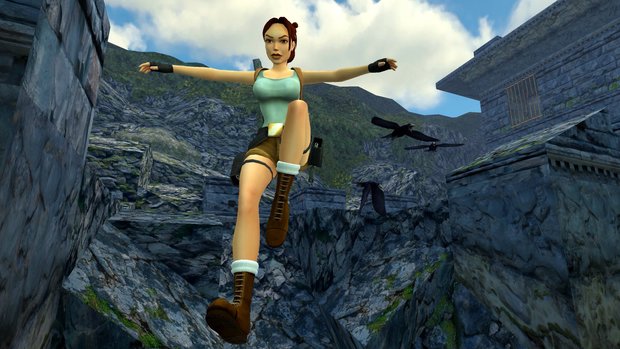
- 0 Comments
A little action with your adventure? Improvements are fairly marginal, but this definitive collection of classics is a great haul overall
The mainstream transition from 2D sprites to realtime 3D polygons during the mid-1990s was an exciting, though admittedly rough, transition for many genres. Core Design’s Tomb Raider stands as an important milestone in gaming, not just because of its curvaceous protagonist and the pop culture impact she spawned, but because of its game design. Simply put, the result was an example of how to do 3D gaming right.
Nowadays, however, many consider the original Tomb Raider games dated because of their clunky controls and blocky graphics. And so Tomb Raider I-III Remastered Starring Lara Croft reaches out to the poly-phobic and tank control-pessimistic with its modernized adjustments, and the sheer amount of content preserved and refined in this package is impressive. Nostalgic franchise fans can still play the original versions in all their old-school glory, while newcomers will appreciate the upgraded graphics and alternate control options more in keeping with later Tomb Raider games. Regardless of whether you choose to ignore the visual veneer and updated controls or embrace them, these original Tomb Raider games remain highly enjoyable and, while often difficult, deliver a thrilling and satisfying action-adventure experience.
Tomb Raider, in case you’ve been living under a rock for the past twenty-eight years, is about a young woman named Lara Croft. Lara is an adventurer and treasure hunter who writes books about her travels, pocketing the occasional souvenir along the way. She grew up an aristocrat but after surviving a plane crash, her outlook on life changed. Both an attentive student and hardened survivalist, she used her skills to explore (and pilfer) the most dangerous and isolated places on the planet. Her parents disowned her, citing her unladylike lifestyle, having transformed her Jacobean mansion with a trophy room of ancient and endangered animal taxidermies, while her dining hall was usurped by a gym and her yard turned into an assault course. It’s pure Bruce Wayne-esque power fantasy stuff, and while her backstory doesn’t come up in-game (at least in these first three games), the task at hand is always interesting enough without it. Lara may frequently be seen as a sex symbol, but she is as smart and witty as she is acrobatic and tough, and she is your avatar for exploring a bunch of trap-filled environments.
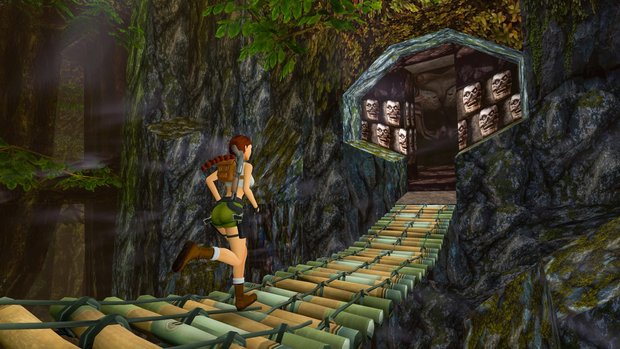
The series 1996 debut was – and now is again – an attitude-infused evolution of its pulp adventure inspirations, filled with radical and hilarious caricatures. The game begins with Croft sitting in a hotel in Calcutta before being approached by a man named Larson. He introduces himself with a wry, “What’s a man gotta do to get that kind of attention from ya?” while tossing a magazine onto the table with a cover that reads: ‘Lara Stamps out Bigfoot!’ Larson represents Jacqueline Natla, who explains that she wants to hire Lara to find an artefact called the Scion of Atlantis, launching an epic journey that spans Peru, Greece, Egypt and the fabled city itself.
It’s the stuff of cartoons, with Lara’s dry wit contrasted against the cold and calculated Natla and her idiodic hired help. Larson’s colleagues include the aptly named Bald Man and Skater Boy, the latter an Uzi-wielding teen who rides a skateboard. The sly (but moronic) Pierre also ambushes Lara throughout several levels, and this supporting cast not only lends the experience a distinctly 90s flavor, but injects the game with welcome moments of humor after extended periods of quiet. As independent and magnetic a character as she is, there is no denying that Lara is, well, kind of a jerk. To her, artefacts don’t belong in a museum, they belong in her personal collection. It’s all silly and in good fun, but this Lara is decidedly aggressive in her acquisition of loot, and in disposing of those who stand in her way. It’s interesting to sit back and ponder at times whether Lara is really the good guy (girl).
In Tomb Raider II, Lara travels from China to Venice before being apprehended and taken to an offshore rig from whence she escapes (after a quick detour underwater) to Tibet. The finale takes place in a psychedelic land of floating jade islands, and the epilogue is easily one of the series’ most memorable levels. The third game sees Lara looking for a piece called the Infada stone in India, though after meeting a Dr. Willard she learns that there are more artefacts like it spread across the globe, at which point the player gets to choose their route before travelling to Antarctica for the climax. While the story is reserved to between-level cutscenes, the narrative is always easy to follow, providing context about the next area. In fact, Lara’s silence during gameplay, in contrast to her quips during cinematics, exudes a sort of calm confidence that is far more effective than spewing one-liners or processing internal monologues.
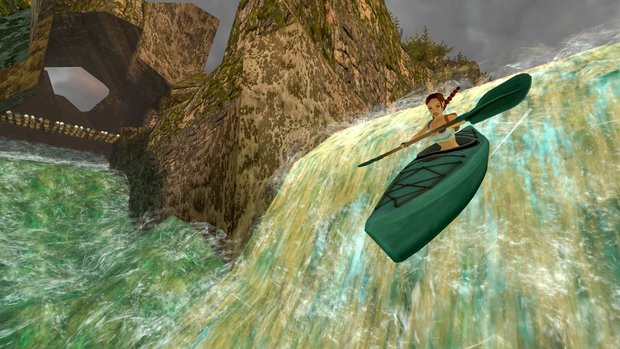
The first game dips into horror territory from time to time, especially in the Egyptian and Atlantean levels, where the texturing comes to resemble something out of a DOOM-era first-person shooter, but the overall vibe is always playful. The lighting effects pioneered in Tomb Raider II are used to great effect, and sequences in Tibet introducing the yetis are far scarier than anything in the first game. The South Pacific levels in Tomb Raider III are far more intense than even the Lost Valley level of the original game, thanks to a slower and more suspenseful build-up toward their grand reveals. While it may not be fair to label Tomb Raider I-III Remastered a horror anthology, there is a good deal of suspense and a few jump scares to be had
A welcome addition to this bundle is the inclusion of the original expansion packs for each game. Tomb Raider’s Unfinished Business sees Lara return to Atlantis before taking a new route out of the flooded Egyptian levels and beyond. Tomb Raider II’s Golden Mask adds five new levels in America, while Tomb Raider III: The Lost Artefact sees Lara explore Scotland and the Paris catacombs. These expansion packs were only ever released on PC (aside from the now-delisted mobile ports of the first two games), and had become quite inaccessible until this release. Their addition not only represents their debut on console, but the first time many players will have to experience them at all.
For existing fans, perhaps the single biggest motivation for considering these remasters is their much-lauded graphical overhaul. I played on the PlayStation 5, which runs the updated versions at 60 frames per second, while the originals run at only 30. You can change back and forth between the old and new graphics at any time with the press of a button, and when switching you can see the notable improvement in polygon count and lighting effects. However, I played through several levels with the original graphics and found them absolutely delightful, while the new look has awkwardly implemented several of the new assets. And because the environmental geometry of the original games is essential to gameplay (more on this later), they could only be smoothed out so much, so don’t come in expecting a complete modern remake.
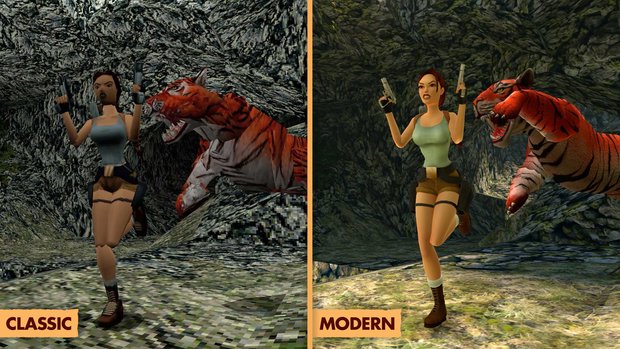
Although limited, the updated textures give old environments a genuinely new feel, and paired with improved lighting effects, they can be simply breathtaking. On the flip side, the once blurry and pixelated paintings adorning Lara’s home are now shown in full clarity, and it’s much easier to see how often they are repeated. (Does Lara collect forgeries just for fun?) The protagonist's new character model is gorgeous, but the poly count of some of the enemies and NPCs have not transitioned as smoothly. Publisher Aspyr has also opted to animate Lara’s mouth in cinematics, but it ends up looking rather wooden, making me wish they had simply kept the simple head-bobbing animation to connote character speech.
Famously, the first game originally employed a blanket black “fog” effect in its rendering, making it feel as though each location was underground. Though this fog shading was improved to feature several gradients for the sequels, with better lighting making each location more atmospheric, the new graphics for Tomb Raider I-III Remastered iron out the transition between games almost entirely. If you play the Lost Valley in Tomb Raider and then India in Tomb Raider III with the new graphics, for example, you could easily mistake them for different levels of the same game, but if you play the same levels with their original graphics, the gap in visual fidelity is immediately evident. Disappointingly, certain other details that were significantly upgraded from the original Tomb Raider to Tomb Raider III can look glaringly awkward in their newly implemented forms. Plants that are supposed to be fixed to the ground in the opening area of the Tomb Raider III's first level, for example, are floating mid-air, having been unceremoniously attached to a slope without accounting for the angle of the surface.
The core gameplay loop of these games is exploration - puzzle solving - combat. The latter is what separates these titles from more traditional adventure games, obviously, but there are still plenty of cerebral challenges to contend with. Puzzles in Tomb Raider come in a variety of forms, sometimes centering around block movement à la ‘Traffic Jam,’ challenging you to make a path by pushing or pulling blocks through calculated movements in confined spaces. Switch puzzles are another staple, with switches opening and closing routes of travel. These triggers are sometimes timed as well, requiring you to not only solve the correct input code, but to successfully navigate your way through the open passage in time.
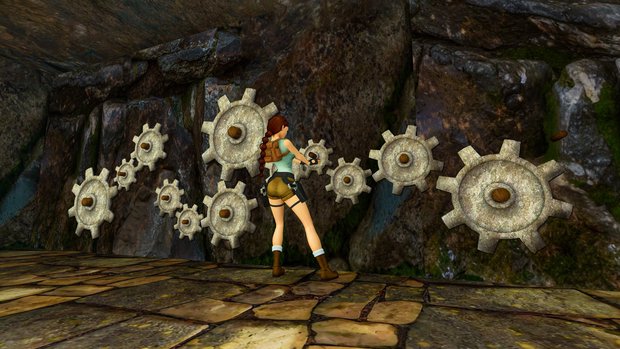
Levels in the original three Tomb Raiders typically start out with a linear corridor before quickly branching into multiple paths. After exploring all available routes of travel, and noting where locked doors or impassable segments exist, it becomes a matter of backtracking to find the necessary keys or switches to continue. Some levels, especially in Tomb Raider III, become quite labyrinthine. Playing through a level in a single sitting can take anywhere between fifteen to ninety minutes to complete, assuming you are sufficiently familiar with the level’s floorplan. Avenues forward aren’t exactly hidden, though the spaces can be so large that keeping track of where certain rooms and circuits lead can be baffling, and there is no in-game map for reference.
Though none of the main obstacles are exceedingly difficult to overcome, leisurely exploring and puzzle solving are broken up by gauntlets of traps and combat ambushes. Traps include collapsible floors, spike pits, lava, whirling blades, poison darts, and the ever cheap hilarious rolling boulders, just to name a few. Some are a bit unfair, like sudden rock drops or collapsing ceilings, giving you too little time to react and no hint as to their trigger, but they are nevertheless avoidable if observant and cautious (or lucky) enough. Other traps, like the infamous sequence of rooms in the first game’s St. Francis’ Folly, and another involving a doppelganger of Lara in Atlantis, are exhilarating to solve, pushing you to take a leap of faith and put Lara in mortal danger, then getting her out before any actual blood is spilled. Midas’ Palace is another deadly favorite puzzle-centric level of the first game; accidentally sending Lara to a (shiny) early grave was not only shocking but provided a clue to what needed to be accomplished in the level to try again.
While the second and third games maintained their predecessor’s charm in level design, the truly imaginative – albeit most sadistic – puzzles were saved for obtaining secrets. Most levels in Tomb Raider games have at least one secret each that are connoted by an audible chime when found. However, there is no guide for searching off the beaten path, and thus players are challenged to check every alcove and shaded area for secret crawlspaces and pits. Or, sometimes the secrets are in plain sight, but reaching them seems impossible due to a large gap or the presence of other barriers, like razor wire or spikes.

Figuring out these optional puzzles will add significantly to your playtime in any given stage, but they reward you with additional items, like health kits and ammunition. If you manage to find all of the secrets in Tomb Raider III, you are even given access to a bonus level. This is no small task, so you must make sure you have not passed a point of no return in any given level without checking every avenue thoroughly, likely requiring you save-scum (no problem thanks to the generous number of save slots allotted) throughout, and check Lara’s handy compass at the beginning of each stage to see how many secrets are hidden within. The final secret in Tomb Raider III’s Aldwych level, for instance, is extremely tough to unlock, as is retracing your route of travel to try to get an extra secret in the South Pacific’s opening level, but successfully finding your way through these trials is incredibly rewarding.
While Tomb Raider certainly impressed upon its initial launch with Lara’s acrobatics and dual-wielded pistols in combat, fighting is rarely a highlight of the experience. In fact, the combat is quite basic, and usually just requires you to roll or jump back and forth to avoid enemies while firing, with Lara automatically targeting her opponent(s). Mind you, some situations do require you to get creative, like working with NPCs to defeat enemies or reaching a platform to safely snipe creatures in the water. Lara will often be ambushed in tight quarters, meaning it's better to run and find higher ground than stand and fight.
Friendly NPCs were introduced in Tomb Raider II, who would only attack Lara if she shot at them. Most monsters will need to hit Lara several times in order to drain her life bar, though some also spit fire or poison (introduced in Tomb Raider III), so you’ll need to change your strategy depending on the makeup of melee and ranged attacks present in each arena. Lara’s weaponry was also revamped for each successive game, with major additions like the spear gun for underwater combat in Tomb Raider II and the all-powerful rocket launcher in Tomb Raider III. Choosing the right weapon for the right situation is key, unless you want to fudge your way through most of the game with Lara’s trusty pistols (which alone have unlimited ammunition), though you’ll be needing a lot more health packs along the way if you don’t master the ins and outs of your arsenal.
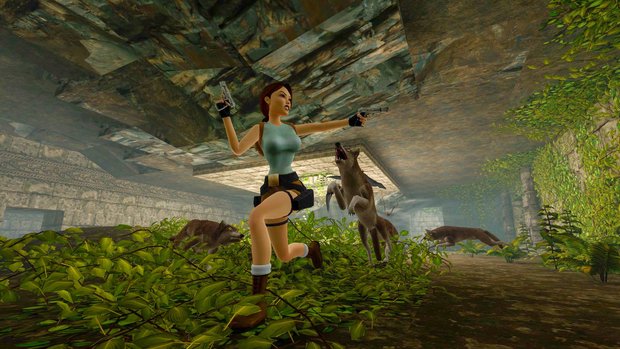
Vehicles, introduced in Tomb Raider II, are typically used throughout most of the levels in which they are featured. The speedboat in Venice is a highlight, both as part of a timed challenge racing through the canals, and simply as a pleasant way to get around and explore. The snowmobiles in the Tibetan Foothills level make for interesting combat scenarios, but are also used to great effect in circumnavigating slopes Lara would otherwise be unable to navigate. The kayak in Tomb Raider III’s Madubu River is a tricky low point for vehicle implementation, but still manages to be an interesting change to the standard exploration formula.
I would also be remiss not to mention Croft Manor. In each of the three games, you can travel to Lara's home for a tutorial or refresher on the basic controls through the main menu at any time. In the first game, the mansion is a mostly linear affair, simply guiding you from the library into the music/tumbling mat room before leading you downstairs to the ballroom/gymnasium. Here you’re given a rundown of how to perform all of the moves you’ll need to navigate the game’s deadly challenges. Just as importantly, however, the first excursion into Croft Manor gave visitors a peek into her private life, showing how this lunatic daredevil lives.
Players wanted more, however, and in Tomb Raiders II and III the scope of Croft Manor was greatly expanded, allowing you to wander a larger area and stay as long as you wished, regardless of whether or not they had completed the basic control tutorial. You can turn on Lara’s music system, go outside and try the obstacle course, or just play hide and seek with her butler, Winston. There are also hidden rooms and secrets throughout the mansion, and figuring out not only where all of the secret passages are, but how they link together, is one of the games’ most satisfying, and adventure-y, aspects.
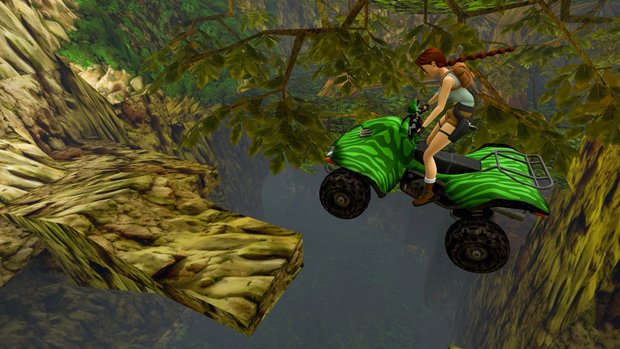
The environments are still blocky despite the graphical overhaul, but this is not a purely aesthetic choice as Lara’s movements have been measured perfectly to reflect the architecture. A single block, for example, is close to one “hop” backwards for Croft, allowing her to perform a running jump and reach further areas. Once you begin to read the environments like this, as in how far (how many “blocks”) a gap is, how high a ledge is, or how steep a slope is, discerning a level’s topography is purely a mathematical exercise. It may seem rigid initially, but once you get the hang of Lara’s arsenal of movements, successfully traversing a scene can be done with absolute grace.
The wonderful thing about the level design in these games is that there are nearly no invisible walls (aside from a few oddities). The levels are playgrounds built to be explored and interacted with Lara’s specific inventory of movements, challenging players’ pathfinding skills, as opposed to placing a fancy backdrop overtop a linear path corralled by unseen barriers. Even if they may look rougher than their brand new contemporaries, these games are considerably more immersive than many modern action-adventure games because of this degree of interactivity.
By default the PS5 remasters have been mapped (more or less) as they were originally on the PlayStation in 1996. The D-pad and left stick move Lara forwards and backwards and turn her side to side – in other words, tank controls. From a standing position she can roll, walk, run, or sidestep, and jump while still facing forward. Lara can also stop to look around, locking her in place while you gain control of her head, allowing you to better examine your surroundings. Sprinting and crawling were added in Tomb Raider III, opening up exploration and level design even more.

If you’re not interested in navigating old-school-style, the “Modern Control” option plays closer to the Legend/Anniversary/Underworld games by Crystal Dynamics. While this inclusion is most likely aimed at new players, veterans may prefer it as well, or at least want to try it out as a novelty. Here, Lara simply follows the directional input of the stick (pressing left will have her travel left, not turn in place, for example), and the camera can be freely rotated with the right stick. The button layout has been altered as well, though the adjustment is easily figured out. Autograb is implemented in this case, allowing you to walk off ledges or jump at a climbable wall and have Lara grab on and stay attached without holding down the action button.
While making some things easier, the new controls make certain movements like backflipping or side jumping near impossible, and the camera follows Lara in some awkward ways. I played through several levels with the Modern Control scheme and found myself constantly fighting with the camera and directional input, having to stop and manually reset it. Furthermore, I found this new setup a bit too floaty for measuring out jumps. The aforementioned autograb helped with this, but I still prefer the more precise platforming of the original versions.
The classic control scheme and camera are serviceable for the most part, following Lara from a centered view and rotating to adjust the direction she is facing when possible. (Small rooms and tight spaces may center the camera elsewhere, meaning you have to use the manual Look function to get a better view.) There are nice cinematic effects, like the camera occasionally pulling back to show a panoramic shot of Lara’s environment, and with the original tank controls these camera adjustments are easy to accommodate. Other nice effects like a bobbing camera while sprinting in Tomb Raider III add a welcome sense of speed and weight to Lara as she moves.
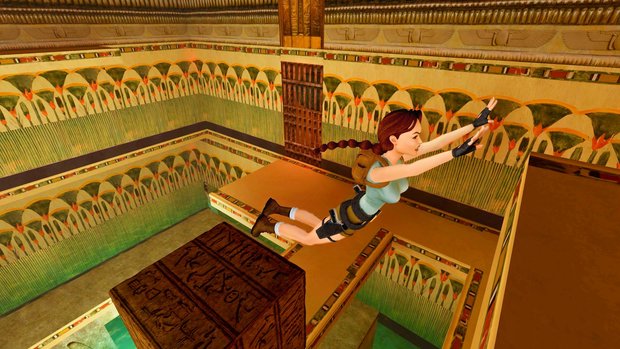
There are still a few anomalies and glitches present in this collection, like the infamous corner bug that can unceremoniously transport Lara to the top of a structure if she clips its corner while moving – or simply lift and then drop her to her death. On one hand, it’s disappointing this wasn’t addressed. On the other hand, it’s a legitimate part of the Tomb Raider glitched speedrunning community, meaning runners can still exploit their old routes. If nothing else, it can get you onto the otherwise inaccessible roof of Croft Manor, just for giggles.
One curious adjustment is the use of save crystals in Tomb Raider III. In the PlayStation and Saturn versions of the original game, you could only record your progress at crystals found throughout the levels. In the second game, PlayStation players were allowed to save as often as they liked at any point, just like the PC version. However, for the third game, save crystals returned. In the PC version they simply replenished Lara’s health, but on PlayStation they were collected like items and could then be used for saving – one crystal for one save game. It made the console version substantially harder, and also forced players to take more risks, sometimes going off the beaten path to look for hidden crystals, or secrets which might contain crystals, all the while putting themselves in more danger and possibly dying before reaching said crystal, and having to do large chunks of the level over again.
In Tomb Raider I-III Remastered, these crystals are simply novelties, having been relabelled “collectable crystals.” Players can save at any point in the game, even on PlayStation 5, like the PC originals, making their inclusion somewhat pointless. In Crystal Dynamics’ Tomb Raider Anniversary, a remake of Core Design’s original game to fit into the reimagined Legend storyline, these crystals were put into levels to trigger a sort of director’s commentary, where Lara Croft creator Toby Gard and other members of the development staff would recount how they approached designing certain parts of the game, even as player was free to continue playing. It was a great addition, and one that would have been perfect for this collection as well.
Nathan McCree’s soundtrack is one of the best parts of these games, his scores swelling to monumental reveals, tense fights, and the ends of levels, as well as occasionally bursting in to shock the player with a chime of brass and chords. Music is absent most of the time, which makes it a treat to hear when it comes in, but that means the long periods of silence must be filled with environmental effects instead. Fortunately Tomb Raider excels in this area as well, with faint echoes and rumbles in the background while exploring tombs and caves, or the rolling water and chirping birds of the tropical levels immersing you fully within the setting.
Final Verdict
Tomb Raider I-III Remastered Starring Lara Croft is an imperfect update but a tremendous package overall, offering a satisfying mix of exploration, puzzle solving and action with enough content to keep you occupied for dozens of hours. While most of the puzzles won’t stall hardcore adventure fans for long, they are nevertheless well-designed and the games encourage exploring to find all the hidden secrets – a formidable challenge for even the experienced gamer. The series looks better than ever with a graphical overhaul, but they’re still clearly old games reskinned rather than brand new AAA games released today. The new control scheme will be embraced by those who found the original mechanics too cumbersome, and yet doing some of the games’ more precise platforming segments may not be as intuitive as before. For longtime series fans, this collection is ultimately singing to the choir – prettier and more flexible, but perhaps without enough significant benefit to make them necessary. But you get three full games and all related expansions in one bundle, with enough options between new and old iterations to cater to any player’s preference. So if you’re missing any games from your collection, or are a fan of the later Tomb Raiders and wondering how it all started, this is an absolute must buy.
Hot take
Aspyr has done an excellent job preserving three of the most important, and timeless, examples of early 3D gaming. Tomb Raider I-III Remastered may largely be a greatest hits set for existing fans, but it’s a comprehensive bundle whose new visuals and updated control schemes are nice options to introduce the original series to the uninitiated.
Pros
- Vast amount of content, with three games and all original expansions
- Challenging but satisfying level design balancing action and puzzle solving
- Immersive audio design with sparse but superb musical score
- Impressive lighting and hi-res texture improvements
Cons
- New (optional) control scheme could have used more tuning
- Some of the rebuilt graphics look awkward
Drew played his own copy of Tomb Raider I-III Remastered Starring Lara Croft on PlayStation 5.










0 Comments
Want to join the discussion? Leave a comment as guest, sign in or register in our forums.
Leave a comment